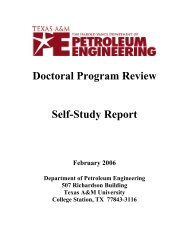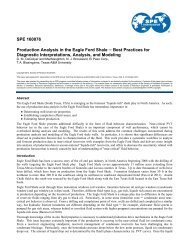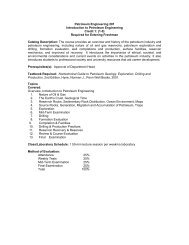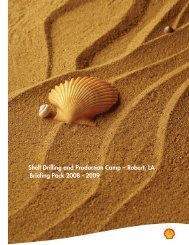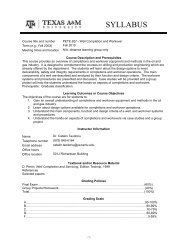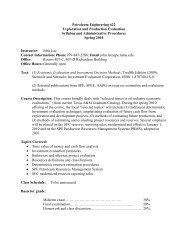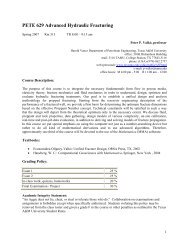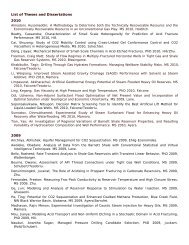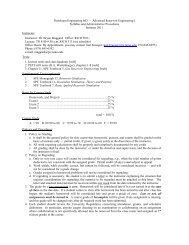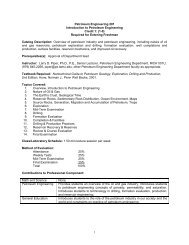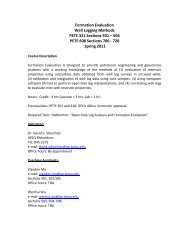Crisman Annual Report 2009 - Harold Vance Department of ...
Crisman Annual Report 2009 - Harold Vance Department of ...
Crisman Annual Report 2009 - Harold Vance Department of ...
You also want an ePaper? Increase the reach of your titles
YUMPU automatically turns print PDFs into web optimized ePapers that Google loves.
In-Situ Oil Upgrading using Tetralin (C 10<br />
H 12<br />
) Hydrogen Donor and Fe(acac) 3<br />
Catalyst at Steam Injection Pressure and Temperature<br />
Objectives<br />
In-situ upgrading has advantages over conventional<br />
surface upgrading technology. First, in-situ upgrading<br />
enhances oil recovery, increases well production,<br />
and lowers lifting and transportation costs from<br />
reservoir to refinery. It eliminates the cost <strong>of</strong> building<br />
catalytic reactors or vessels. The in-situ process can<br />
be applied onshore or <strong>of</strong>fshore as well as in remote<br />
locations where surface facilities may be prohibited.<br />
Second, in-situ upgrading can be applied on a wellto-well<br />
basis, and thus can be adjusted for declining<br />
production rates whereas surface processing are<br />
designed for a specified range <strong>of</strong> crude volume.<br />
Third, implementation <strong>of</strong> in-situ upgrading reduces<br />
energy consumption since the same energy from<br />
steam injection is used to produce and upgrade the<br />
oil. Finally, in-situ upgrading is more environmentally<br />
friendly, yielding lower quantities <strong>of</strong> byproducts that<br />
reduce disposal expenditures.<br />
The main objectives <strong>of</strong> the research are as follows:<br />
» Follow up on research by Ahmad Mohammad, for<br />
example, in-situ oil upgrading using tetralin (C 10<br />
H 12<br />
)<br />
and Fe(CH 3<br />
COCHCOCH 3<br />
) 3<br />
[i.e., Fe(acac) 3<br />
] catalyst<br />
at steam injection pressure and temperature as<br />
found in the field.<br />
» Make runs in which we inject a slug or slugs <strong>of</strong><br />
tetralin/catalyst followed by steam injection.<br />
» Simulate longer injection periods in the experiments<br />
by making runs for several days, stopping at the<br />
end <strong>of</strong> each day.<br />
» Make runs using a reactor cell and synthetic oil<br />
made <strong>of</strong> several pure components (similar to<br />
Ramirez’s PhD research). Analyze any change<br />
in synthetic oil composition by GC analysis. This<br />
type <strong>of</strong> experiment will help us determine which<br />
components are upgraded by tetralin/catalyst, and<br />
then extrapolate the results to actual oil.<br />
» For both displacement and reactor cell experiments,<br />
investigate the effect <strong>of</strong> steam-surfactant injection<br />
to lower IFT and thus increase recovery factor.<br />
Approach<br />
For reactor cell experiments, one single hydrocarbon<br />
component will be used for each run. The hydrocarbon<br />
component, water, tetralin, and catalyst are<br />
mixed in the cell and then pressurized and heated<br />
to reservoir steam flooding conditions for a period<br />
<strong>of</strong> time. At the end <strong>of</strong> the run, a sample <strong>of</strong> the<br />
liquid from the cell is removed and its composition<br />
analyzed using a GC.<br />
For injection tests, the experimental apparatus (Fig<br />
1) is made up <strong>of</strong> four main parts: injection cell, fluid<br />
injection system, fluid production system, and data<br />
recording system.<br />
The experimental procedure is as follows:<br />
(1) Prepare sand/water/oil mixture, (2) Tamp<br />
mixture into injection cell and pressure test, (3)<br />
Install injection cell into vacuum jacket and pressure<br />
test whole system, (4) Set heating jacket to reservoir<br />
temperature and leave overnight, (5) Condition<br />
steam generator and pressurize injection cell, (6)<br />
Start tetralin or tetralin-catalyst injections (only for<br />
injection runs), and (7) Start steam injection and<br />
collect samples.<br />
Accomplishments<br />
Set up reactor cell, GC and other equipment, and<br />
investigated chemical requirements for research.<br />
Reviewed papers and books on oil upgrading using<br />
tetralin/catalyst.<br />
(continued on next page)<br />
Project Information<br />
1.3.17 Experimental Studies <strong>of</strong> Non-Thermal EOR Methods<br />
for Heavy and Light Oil Recovery<br />
Related Publications<br />
Mohammad, A. A. and Mamora, D. D. In-Situ Upgrading <strong>of</strong><br />
Heavy Oil under Steam Injection with Tetralin and Catalyst,<br />
Paper presented at the 2008 International Thermal<br />
Operations and Heavy Oil Symposiums, Calgary, Alberta,<br />
Canada, 20-23 October.<br />
Contacts<br />
Daulat Mamora<br />
979.845.2962<br />
daulat.mamora@pe.tamu.edu<br />
Zhiyong Zhang<br />
CRISMAN INSTITUTE<br />
<strong>Crisman</strong> <strong>Annual</strong> <strong>Report</strong> <strong>2009</strong><br />
31



